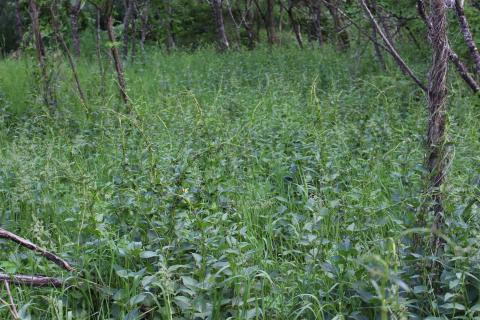Invasive in the Spotlight: Swallow-wort

Swallow-wort, alternatively spelled swallow wort and swallowwort, is an invasive plant in the milkweed family. Two species are of concern in the Northeast: black swallow-wort (Cynanchum louiseae) and pale swallow-wort (Cynanchum rossicum). Both are climbing vines and herbaceous perennials, meaning they die to the ground in winter. Although it is doubtful they could have been considered attractive plants, it is believed they were introduced to the US from Europe as ornamentals in the 1800s.
The two species of concern are highly similar. They have opposite leaves on twining green stems and can grow to a height of six feet. The main difference is that black swallow-wort has dark purple star-shaped flowers, while the pale swallow-wort’s flowers, while also star-shaped, are thinner and vary from pink to red. The plants have short underground rhizomes, but mostly propagate by seed. Seeds disperse from pointed pods in late summer.
Both plants are considered highly invasive with severe consequences for the environment. Swallow-wort is challenging to control and is very hardy. It can’t be pulled, as it breaks off at the ground and the roots quickly sprout again. It has no native enemies; virtually nothing feeds on it successfully. It disperses its seeds by wind. It grows readily in both shade and full sun, forming dense mats that crowd out native understory plants. Swallowwort is allelopathic, meaning its roots release compounds that can suppress the growth of other plants.
If it lacks something to climb upon, the plants will twine upon themselves forming ropes. It is this trait that earns it the nickname “dog-strangling vine.” There is also concern that monarch butterflies will mistake swallow-wort for native milkweeds and lay their eggs upon them, only to have their caterpillars starve.
Control
Control of swallow-wort is challenging. Individual plants can be dug up and destroyed, but the fleshy root system must be thoroughly removed or the plant will just re-sprout. If the plants have become established in a lawn or pasture they can be mowed, which will not kill them but will limit their growth and seed formation. Picking and destroying the seed pods before they open can also help reduce the plant’s spread. Careful use of herbicides, such as glyphosate or triclopyr, can be effective when applied at flowering time (early June). Repeated applications may be necessary to achieve control. If possible, areas cleared of swallow-wort should be quickly replanted with native groundcover species to reduce the chance of re-infestation.
For more information on this noxious invasive consult the following resources:
Black and Pale Swallow-worts from Michigan State University
Black & Pale Swallow-wort from the NH Department of Agriculture
UNH Cooperative Extension Master Gardener volunteers share information about home, yard, and garden topics with the people of New Hampshire. Got questions? Master Gardeners provide practical help finding answers to your questions through the Ask UNH Extension Infoline. Call toll free at 1-877-398-4769, Monday to Friday, 9 a.m. to 2 p.m., or e-mail us at answers@unh.edu.
Related Resource(s)
Do you love learning about stuff like this?
SUBSCRIBE TO Granite State Gardening newsletter
Got questions? The UNH Extension Yard and Garden Infoline offers practical help finding answers for your yard and garden questions.
Call toll free at 1-877-398-4769, Monday to Friday, 9 a.m. to 2 p.m., or fill out webform.
%20copy.jpg)

